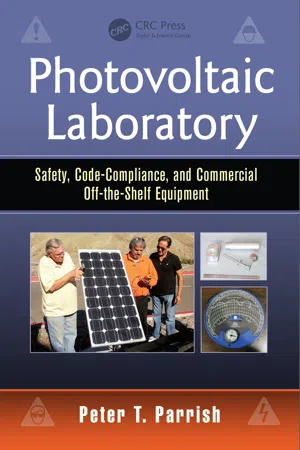
Photovoltaic Laboratory
Safety, Code-Compliance, and Commercial Off-the-Shelf Equipment
- 362 pages
- English
- ePUB (mobile friendly)
- Available on iOS & Android
Photovoltaic Laboratory
Safety, Code-Compliance, and Commercial Off-the-Shelf Equipment
About This Book
Photovoltaic Laboratory: Safety, Code-Compliance, and Commercial Off-the-Shelf Equipment is the only textbook that offers students the opportunity to design, build, test, and troubleshoot practical PV systems based on commercially available equipment. Complete with electrical schematics, layouts, and step-by-step installation instructions, this hands-on laboratory manual:
- Promotes "safety first" by covering working in extreme weather conditions, personal protective equipment, working at heights, electrical safety, and power tool safety
- Includes chapters on trade math, DC/AC electrical circuits, and assessing a property for a photovoltaic system (e.g., surveying the available space, shading, and solar harvest)
- Discusses aspects of mechanical and electric integration specific to different roof types, and characterizing a PV module under different levels of irradiation and ambient temperature
- Addresses the design, installation, and testing of off-grid PV systems with DC-only loads and with DC and AC loads, as well as 2.4 kw DC grid-tied PV systems with microinverters and string inverters
- Trains students on exactly the sort of equipment that they will encounter in the field, so they gain valuable experience and skills that translate directly to real-world applications
Photovoltaic Laboratory: Safety, Code-Compliance, and Commercial Off-the-Shelf provides in-depth, project-driven instruction on everything from attaching brackets and flashing to modeling PV cells, modules, and arrays. This textbook is ideal preparation for those seeking a career in the PV industry—from system installers and designers to quality assurance and sales/marketing personnel.
Frequently asked questions
Information
Safety1
1.1 Introduction
1.2 Student Learning Objectives
- Appraise a job situation and take appropriate measures to mitigate adverse safety conditions related to heat stress, including dressing appropriately for different outdoor environments
- Recognize symptoms of heat stress and respond appropriately
- Appraise working conditions at heights
- Demonstrate proper use of extension ladders
- Implement fall prevention and fall protection procedures employing appropriate equipment
- Identify and understand electrical hazards and how to mitigate them
- Identify and properly use appropriate personal protective equipment
1.3 Working in Extreme Weather Conditions
Table of contents
- Preface
- Acknowledgments
- Introduction
- How to Use This Textbook
- The Author
- Chapter 1 - Safety
- Chapter 2 - Trade Math for PV—Measurements, Units, and Calculations
- Chapter 3 - Measurements of DC and AC Electrical Circuits
- Chapter 4 - The Site Survey
- Chapter 5 - Racking Systems—General Considerations
- Chapter 6 - Characterization of a PV Module
- Chapter 7 - Modeling the PV Cell, Module, and Array
- Chapter 8 - Lead-Acid Absorbent Glass Mat Batteries
- Chapter 9 - Off-Grid PV System with DC-Only Loads
- Chapter 10 - Off-Grid PV System with DC and AC Loads
- Chapter 11 - 2.4 kW DC Grid-Tied PV System with Microinverters
- Chapter 12 - 2.4 kW DC Grid-Tied PV System with String Inverter
- Appendix I: Small Mock Roofs
- Appendix II: Roll-Around Walls
- Appendix III: 21 ft. by 18 ft. Roof